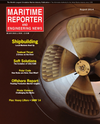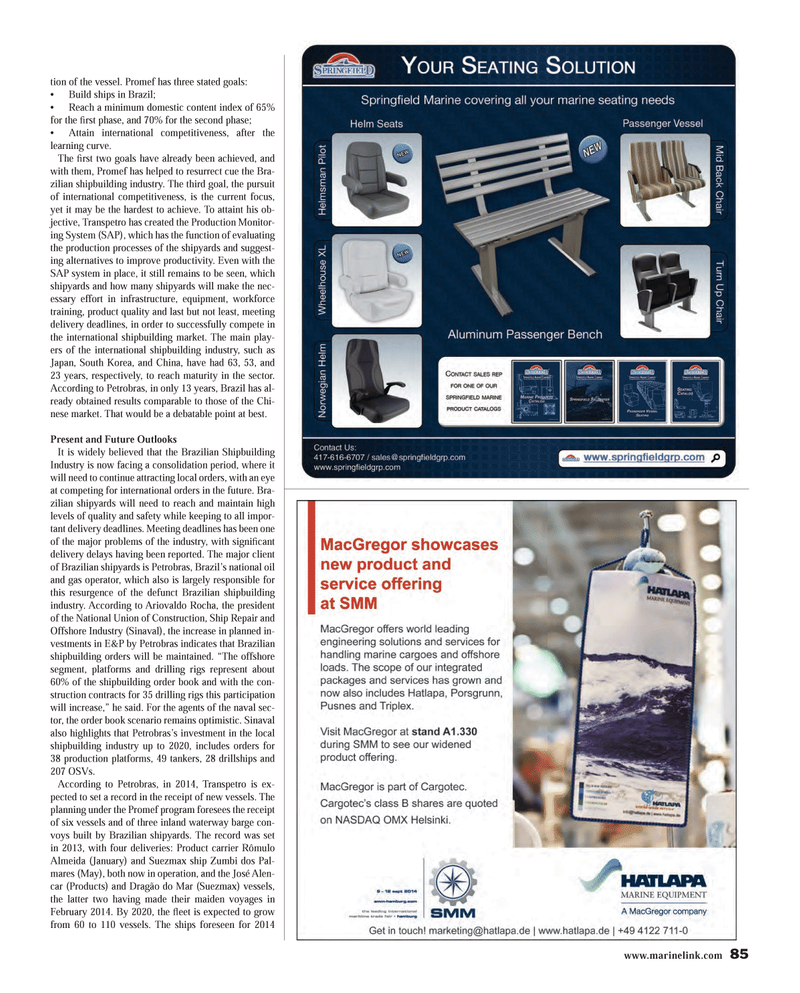
Page 85: of Maritime Reporter Magazine (August 2014)
Shipyard Edition
Read this page in Pdf, Flash or Html5 edition of August 2014 Maritime Reporter Magazine
www.marinelink.com 85tion of the vessel. Promef has three stated goals:? Build ships in Brazil; ? Reach a minimum domestic content index of 65% for the Þ rst phase, and 70% for the second phase; ? Attain international competitiveness, after the learning curve.The Þ rst two goals have already been achieved, and with them, Promef has helped to resurrect cue the Bra-zilian shipbuilding industry. The third goal, the pursuit of international competitiveness, is the current focus, yet it may be the hardest to achieve. To attaint his ob- jective, Transpetro has created the Production Monitor- ing System (SAP), which has the function of evaluating the production processes of the shipyards and suggest-ing alternatives to improve productivity. Even with the SAP system in place, it still remains to be seen, which shipyards and how many shipyards will make the nec-essary effort in infrastructure, equipment, workforce training, product quality and last but not least, meeting delivery deadlines, in order to successfully compete in the international shipbuilding market. The main play- ers of the international shipbuilding industry, such as Japan, South Korea, and China, have had 63, 53, and 23 years, respectively, to reach maturity in the sector. According to Petrobras, in only 13 years, Brazil has al-ready obtained results comparable to those of the Chi-nese market. That would be a debatable point at best. Present and Future Outlooks It is widely believed that the Brazilian Shipbuilding Industry is now facing a consolidation period, where it will need to continue attracting local orders, with an eye at competing for international orders in the future. Bra-zilian shipyards will need to reach and maintain high levels of quality and safety while keeping to all impor- tant delivery deadlines. Meeting deadlines has been one of the major problems of the industry, with signi Þ cant delivery delays having been reported. The major client of Brazilian shipyards is Petrobras, Brazil?s national oil and gas operator, which also is largely responsible for this resurgence of the defunct Brazilian shipbuilding industry. According to Ariovaldo Rocha, the president of the National Union of Construction, Ship Repair and Offshore Industry (Sinaval), the increase in planned in- vestments in E&P by Petrobras indicates that Brazilian shipbuilding orders will be maintained. ?The offshore segment, platforms and drilling rigs represent about 60% of the shipbuilding order book and with the con-struction contracts for 35 drilling rigs this participation will increase,? he said. For the agents of the naval sec-tor, the order book scenario remains optimistic. Sinaval also highlights that Petrobras?s investment in the local shipbuilding industry up to 2020, includes orders for 38 production platforms, 49 tankers, 28 drillships and 207 OSVs.According to Petrobras, in 2014, Transpetro is ex- pected to set a record in the receipt of new vessels. The planning under the Promef program foresees the receipt of six vessels and of three inland waterway barge con- voys built by Brazilian shipyards. The record was set in 2013, with four deliveries: Product carrier Rômulo Almeida (January) and Suezmax ship Zumbi dos Pal-mares (May), both now in operation, and the José Alen- car (Products) and Dragão do Mar (Suezmax) vessels, the latter two having made their maiden voyages in February 2014. By 2020, the ß eet is expected to grow from 60 to 110 vessels. The ships foreseen for 2014 MR #8 (82-89).indd 85MR #8 (82-89).indd 858/5/2014 10:03:01 AM8/5/2014 10:03:01 AM

 84
84

 86
86
